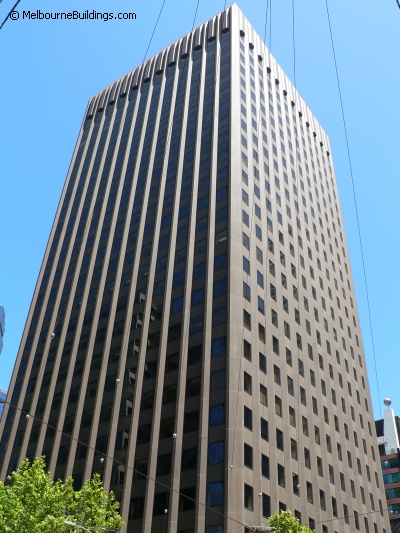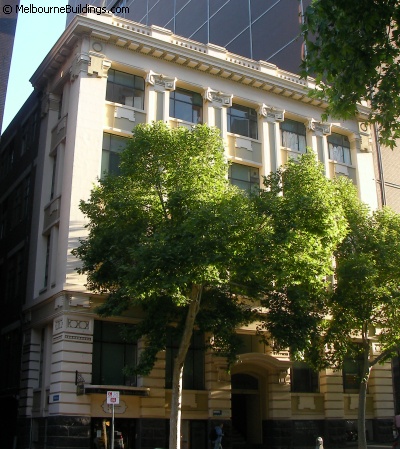
 AMP Square: 535 Bourke Street, Melbourne
AMP Square: 535 Bourke Street, Melbourne

AMP Square's main tower at 535 Bourke Street, Melbourne viewed from the corner of Bourke and William streets
This 26 storey 113 metre building was completed in 1969. Constructed on part of the site of John Sanderson & Co. woolbroking premises, St. James Building, 111 William Street, a large five storey second empire building which spanned an entire city block.
Designed by United States architectural firm Skidmore Owings & Merrill in partnership with local firm Bates Smart & McCutcheon1, the building and its plaza are an example of stark corporate modernism with obvious influences of Eero Saarinen’s CBS building in New York City. Nevertheless, the AMP building, is one of Melbourne’s classic 1960s buildings. The facade is clad in a simulated brown stone (compressed granite) veneer. The square tower has bevelled piers rising the full height of the building to a double storey crown at the top. The piers and spandrels effectively frame series of recessed square windows. Situated in a group of towers which includes former BHP tower opposite at 140 William and Eagle House it forms an important group dating to the same era.
At the base of the tower is the St James buildings, theatrette, shopping concourse, plaza and a large scultpure in the forecourt. The distinctive St James buildings are a most distinctive abstract design, featuring raked diagonal pears that dramatically lean backward sheltering long balconies and causing unexpected perspectives. The sculpture called “Awakening” by Clement Meadmore, one of Melbourne’s iconic works of 1960s public art features a long twisted rectangular prism in weathering steel (Cor-ten) colouring it in a similar brown to the surrounding towers2.
During the 1990s, the tower was to be replaced by a larger development to be known as Church Place, a 70 storey 302m tower designed by Philip Vivian of Bates Smart3 (Bates Smart being one of the partners of the original AMP Square. Having been listed by the National Trust with state significance, AMP Square was nominated to Heritage Victoria however it was refused a listing. The proposal was later reduced to 274m and also involved architects Metier3. However it did not go ahead.
The interiors of the tower were later refurbished.
In late 2010, construction at AMP Square involved extensive modification including covering St James plaza with a canopy.
AMP Square is frequently used as a backdrop for the AUstralian television show City Homicide.
References
- A.M.P Square: A new giant on Melbourne’s skyline. National Library of Australia. 1970 ↩
- pg 192 Goad, Philip. Melbourne Architecture. Watermark Press, Sydney 1999 ↩
- Bates Smart profile Philp Vivian ↩
 Former Michaelis Hallenstein & Co: 441-445 Lonsdale Street, Melbourne
Former Michaelis Hallenstein & Co: 441-445 Lonsdale Street, Melbourne